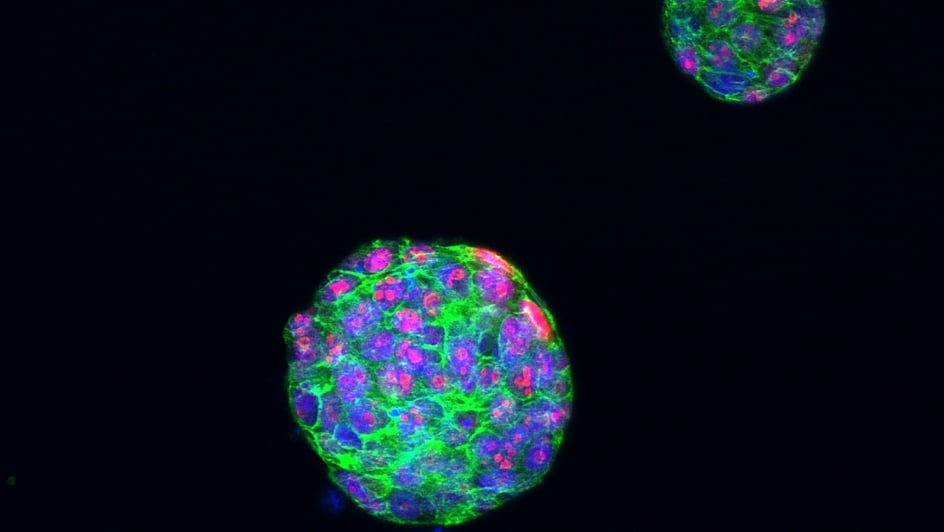
Image: Proliferating cells in a tumour organoid of triple-negative breast cancer. Credit: Dr Rebecca Marlow, The Institute of Cancer Research, London.
Researchers at The Institute of Cancer Research, London, have increased our understanding of how a cancer drug called a PARP inhibitor stops working in women with breast cancer that has spread. This research could ultimately help predict who’s more likely to respond to these drugs, and could lead to more effective ways to treat the disease.
PARP inhibitors and drug resistance
PARP inhibitors are a type of targeted therapy that is used to treat breast cancers with a faulty BRCA1 or BRCA2 gene.
Cancer cells with mutations in the BRCA1/2 genes are unable to fix damaged DNA by a process known as homologous recombination, or HR. PARP inhibitors cause a type of DNA damage that only cells with normal forms of BRCA1 and BRCA2 can repair. This means that PARP inhibitors kill cancer cells with BRCA1/2 mutations, but leave normal cells – which are able to fix damaged DNA by HR – relatively unharmed.
Unfortunately, breast cancer cells can sometimes become resistant to PARP inhibitors. Although researchers have previously found multiple ways cancer cells can evade the effects of PARP inhibitors in laboratory experiments, until now it was unclear how PARP inhibitor resistance happens in women with metastatic breast cancer.
Analysing cancer DNA
Professors Andrew Tutt and Chris Lord from the Breast Cancer Now Toby Robins Research Centre at The Institute of Cancer Research (ICR), with colleagues from the sister Research Unit at King’s College London, analysed tumour DNA of 47 people with advanced breast cancer that was or became resistant to PARP inhibitors. Using an advanced technique called ‘ctDNA profiling’, the researchers worked out the sequence of short pieces of DNA produced by cancer cells that have found their way into the bloodstream.
The research, published in Annals of Oncology and funded by Breast Cancer Now, Cancer Research UK, the Breast Cancer Research Foundation and a Marie Sklodowska-Curie Fellowship, found that in 60 per cent of women with PARP inhibitor resistance, the DNA sequence of the faulty BRCA gene had changed so that the gene could work again. These new ‘reversion’ mutations restore the function of the proteins that BRCA1 or BRCA2 genes make, meaning that the cancer cells could survive the effects of PARP inhibitors.
The team also found that some women with PARP inhibitor resistance had changes to other genes known to stop PARP inhibitors from working, such as changes in a gene called TP53BP1, and that these and the BRCA gene reversions could both occur in the same patient. This finding could inform the design of future trials for treatments to overcome PARP inhibitor resistance.
Looking ahead
The team also noticed that the disease progressed much quicker in people whose cancer showed signs of BRCA1/2 gene reversions before starting treatment. In the future, this information could potentially help inform treatment decisions – giving these patients alternative treatments before their cancer progresses.
Professors Tutt and Lord hope that by understanding what causes PARP inhibitor resistance, they could eventually identify better ways of treating breast cancer – work that has already started in their laboratory.
Professor Andrew Tutt, Professor of Breast Oncology and Director of the Breast Cancer Now Toby Robins Research Centre at The Institute of Cancer Research, London, and the Breast Cancer Now Research Unit at Kings College London, said:
“The discovery that PARP inhibitors could have benefit for BRCA-mutated cancers – which was made here at the ICR – has had a monumental impact on patients’ lives. However, we know there’s more work to be done as some people develop resistance to the drugs and sadly see their cancer progress. Our research has uncovered clues as to why that may be, and we hope to use this knowledge to develop tests that can detect who is at greatest risk of becoming resistant to PARP inhibitor treatment, develop new treatments to tackle resistance – and take action before their breast cancer progresses.”